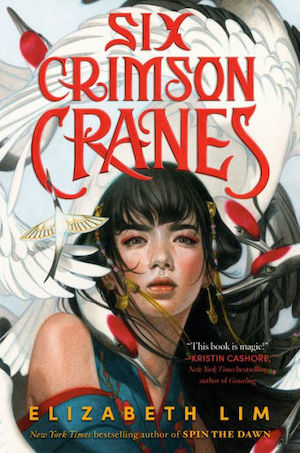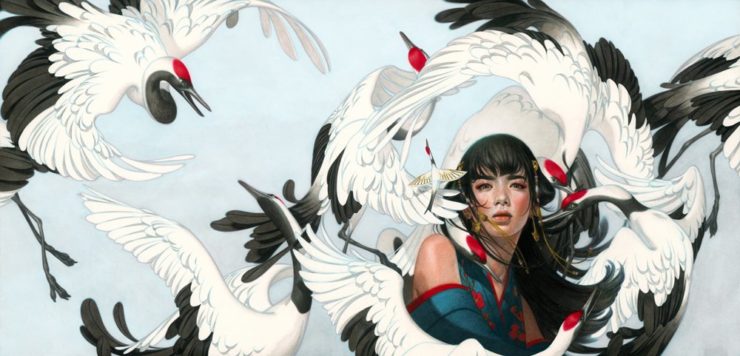Princess Shiori’anma of Kiata would rather spend her days snacking in the kitchen than attending lessons, stitching embroidery, or practicing the zither. It’s no wonder she’s been my favorite character to write! A self-proclaimed glutton, she will go to any lengths to procure rice cakes and roasted sweet potatoes at the annual Summer Festival, and when her fortunes change, she must learn to cook for herself to survive. When I was writing Six Crimson Cranes, that was where the fun began.
Since my books are mostly sold in Western countries, I’ve been passionate about bringing awareness of East Asian folklore, culture, and food to Western audiences. Most of the food in Six Crimson Cranes has Chinese or Japanese roots, and the two dishes Shiori loves most are inspired by childhood treats that my grandmothers used to make. Her fish soup is a reincarnation of the heartwarming soup my maternal grandmother made me when I was growing up, and the cakes Shiori sings about are inspired by the Southeast Asian kuih, which my paternal grandmother often bought and prepared for me when I visited her in Malaysia.
As much as Shiori loves food, she doesn’t start out as a good cook. After all, she begins the story as a spoiled princess who has every dish imaginable at her beck and call. But after her stepmother curses her brothers into cranes and leaves Shiori voiceless and alone, Shiori must earn her keep as a hired cook in a tavern. There, she learns to prepare her one and only dish: fish soup.
My maternal grandmother likes to joke that when I was a baby, I’d cry if there wasn’t fish soup at dinner. The savory soups my grandmother made for me (carrot soup and fish soup with rice were my favorites) are more like broths than the soups in a Western chef’s repertoire. There’s no cream or butter or pureeing, and it’s generally a thinner texture. In my family, fish is believed to nourish the brain as well as the body. And we often prepare our soup with copious vegetables, such as carrots, Napa cabbage, mustard greens, and, as in Six Crimson Cranes, radishes.
Shiori’s fish soup is not a showstopper dish, and it’s certainly not something a critic would wax rhapsodic about. But its simple, hearty flavors evoke home, and for Shiori, that’s worth more than gold.
***
Shiori’s Fish Soup
- 8 ounces tilapia or catfish, cleaned (I find it easier to use fillets since there are no bones.)
- salt or soy sauce
- sesame oil
- ginger
- green onions
- 1 pack soft tofu
- 1 cup shredded Napa cabbage
- 2 to 3 carrots, peeled and sliced into 1-inch pieces
- 4 to 8 ounces peeled sliced white radishes
- chicken stock (optional, but makes for better flavor)
- Marinate the fish with soy sauce OR salt for 30 minutes.
- Brown the fish lightly in sesame oil with ginger and onions in the bottom of a soup pot, but don’t cook it all the way through.
- Pour about half a gallon of water over the fish, let boil, then add the tofu, Napa cabbage, carrots, and radishes, bring to a boil again, then simmer on medium heat for about 30 minutes.
- Garnish with spring onions or minced ginger, and serve in your favorite bowl for a stomach-warming treat!
***
Dessert is something I could talk about for hours. So could Shiori. She has dozens of cakes that she adores, but there is one cake in particular that her mother used to make that she loves above all others.
Shiori’s cakes have multiple inspirations: Chinese peanut dumplings (tang yuan), Japanese yaki mochi (grilled rice cakes), and kuih, bite-size cakes from Southeast Asia. In the song she sings, the cakes most closely resemble kuih, but it is more of a nostalgic homage to the cakes I grew up eating than an authentic rendering. There must be hundreds of different kinds of kuih: they range in color from vibrant pink to pale purple to yellow and green, and they come in many different shapes: flowers, hearts, leaves. They’re gorgeous and are art to look at as well as eat. Shiori’s “monkey cakes” are a simple version, cobbled together from the meager ingredients she has to work with. No coconut, no grated cassava, no pandan—but she manages to make the cakes her own. They’re chewy and moist on the outside and crunchy and sweet on the inside, thanks to the peanut filling. They’re irresistible!
There’s a reason Shiori’s cakes are influenced by Southeast Asian desserts, but I can’t share that without giving away too much of the story. I’ll skip straight to the recipe:
***
Shiori’s Peanut Cakes

Peanut filling:
- ½ cup ground peanuts, salted and roasted
- 2 to 3 tablespoons sugar
- 1 tablespoon cooking oil
Dough:
- 1 cup of glutinous rice flour
- ½ cup boiled hot water
- boiled carrots (in Shiori’s cakes to make them orange—optional)
- Mix the ground peanuts, sugar, and oil until desired consistency is reached. Chill in the fridge while you prepare the dough.
- Combine rice flour with hot water (one tablespoon at a time), until you have a doughlike texture. Blend with the boiled carrots (if desired).
- When ready, shape the dough into 1-inch balls, flatten, and place peanut filling. (Melon scoopers are useful here!). Steam for 6 to 8 minutes.
- Arrange the cakes on a tray or dish, and serve at room temperature. Enjoy!
***
I hope these two recipes give you a taste of what to expect in the food of Six Crimson Cranes! My advice is not to read this book while hungry!
Buy the Book


Six Crimson Cranes
Elizabeth Lim is the author of the critically-acclaimed and bestselling The Blood of Stars duology (Spin the Dawn and Unravel the Dusk), the New York Times bestseller So This is Love, and the USA Today bestseller Reflection. Forthcoming books include the Six Crimson Cranes duology, expected summer 2021 and summer 2022, respectively. Visit her website, or find her on Twitter and Instagram.










